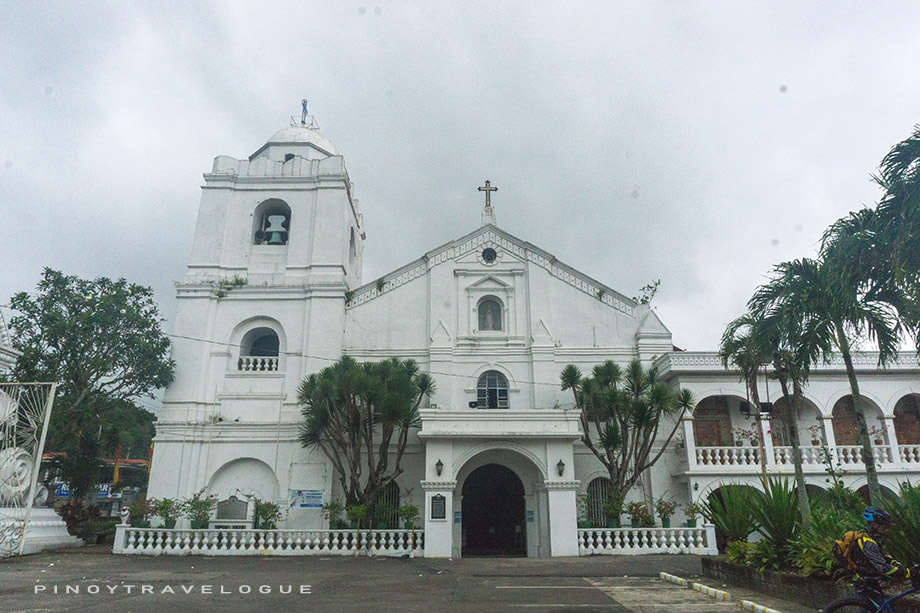 |
Eastern Laguna is a scenic drive. The towns on this side of the province lie sandwiched between the shores of Laguna Lake and the mountains of Sierra Madre, thus the refreshing lush mountain view on one side and the calming vista of the vast lake on the other. Central to these towns are its centuries-old churches erected when Philippines was under colonial rule. Churches that are rich in ecclesiastical history, cultural treasures and stories of Filipino heroism.
Here's a list of some scenic towns in Laguna to visit for the traditional Visita Iglesia.
Mabitac | Nuestra Señora de Candelaria Parish Church
Mabitac Church houses a seventeenth century image of Our Lady of Candles. Its provenance began with a certain Cristobal de Mercado who donated the image to Paco Church; it then resided at a hospital in Los Banos before it reached the chapel situated between two remote barrios in Siniloan. The town's priest decided the image to stay in the chapel when the natives-turned-devotees resisted a transfer, thereafter establishing a new town—Mabitac came into being, the chapel became the first Mabitac Church. However, the barrios were in a low-lying land and often awash, hence town citizens moved the church to its present site—up on a hill called Kalbaryo.
A 126-step stone staircase leads to the church's side entrance. On one side, the church overlooks lush mountains and the entire town below, and on the other, a relaxing vista of Laguna Lake. Below the hill is a colorful monument depicting the historic Battle of Mabitac.
READ ALSO: Mabitac Church and the Battle of Mabitac Mural
 |
| Mabitac Church |
Pakil | St. Peter of Alcantara Parish Church
Pakil lies at the foothills of Sierra Madre, its town center settles by the shores of Laguna Lake. Verdant mountains backdrop the charming, weathered-looking Pakil Church—cream-colored, like a rusting metal structure or a huge house made of aged wood. It's like an ancient edifice that nature's about to reclaim.
Housed within the church is the 9" x 11" oil painting of Our Lady of Sorrows that fisherfolks in Laguna de Bay found afloat in 1788, which, according to historical accounts, providentially chosen Pakil to be its home. The revered icon is center to the town's Turumba Festival, a religious celebration commemorating the Seven Sorrows of Mary (Pistang Lupi as it is known in the Philippines).
 |
| Pakil Church |
Paete | St. James the Apostle Parish Church
Paete Church is within easy reach of Pakil; ika nga sa Tagalog, hindi pa umiinit ang puwit mo sa sasakyan, nakarating ka na. Like Pakil, Paete is at the foothills and the town's church is by the lake, hence the rustic vibe and the picturesque drive.
Paete Church is relatively small, but impressive inside and out. Its retablo and collection of religious images are exquisite. After all, Paete is home to world-class carvers. Even the façade is a marvel in stone carving. The church also houses four giant, centuries-old paintings that belongs to the roster of the country's National Cultural Treasures.
READ ALSO: Paete Church and Its Treasures
 |
| Paete Church |
Pagsanjan | Our Lady of Guadalupe Parish Church
This marble white church amidst the bustling intersection in downtown Pagsanjan is relatively new. It was built only when the air bombings of World War II reduced the original seventeenth century stone church to rubbles. Over the ruins, the present church was reconstructed, a replica of the old, but lacking the original's grandiose dome. The church is designated as a diocesan shrine of Our Lady of Guadalupe. In 1688, an image of the Our Lady which came from Mexico was enshrined on the main altar of the earlier bamboo-and-nipa church. The image was destroyed along with the stone church. Today's life-size image inside Pagsanjan Church is a gift from Mexican Catholics given through the Philippine consul in 1958.
The famous Aling Taleng's Halo-halo stands just across a bridge from the church. One can savor the icy dessert while relishing a view and the calming breeze of Pagsanjan River before proceeding to the next church.
 |
| Pagsanjan Church |
Magdalena | Sta. Maria Magdalena Parish Church
A wooden church was erected when Magdalena, then a barrio of Majayjay, became independent in 1820. The present Baroque church made of adobe and sandstone was begun in 1829 until its attached four-level, square-based octagonal bell tower was completed in 1861. Inside the church's convent stands Emilio Jacinto's shrine, at the spot where his blood dripped when he got wounded in the battle at Maimpis River—Magdaleños believe that the smudges have not disappeared after more than a century.
Mown grass covers the churchyard that adjoins the town square. The spacious plaza complex—a mix of well-trimmed lawn, manicured gardens, modern park amenities and extant Spanish Period edifices—is a playground to locals and a relaxing spot that allures sightseers. Because of the town center's laid-back ambiance, Magdalena is a go-to location when filmmakers need a rural setting or a scene depicting the Spanish colonial era. Magdalena Church appeared in a slew of films since the post-war decades, such as in the hit 2015 biopic Heneral Luna.
 |
| Magdalena Church |
Liliw | St. John the Baptist Parish Church
Liliw gets a countryside allure from the fiery orange Baroque church made of mud bricks and its calming mountain-and-sky background that altogether presents a rural feel. Bright white, life-size statues of saints upon red brick podiums fringe the walkways of the church patio; at the center, the Sacred Heart of Jesus welcomes pilgrims that arrive from the main gate.
The town's narrow streets where tsinelas stores stand abreast connect to the church. Liliw is known for its thriving footwear industry that it holds an annual Tsinelas Festival. One might want to shop around for a pair of Liliw-made footwear when visiting the church.
READ ALSO: Liliw Gat Tayaw Tsinelas Festival
 |
| Liliw Church |
Pila | San Antonio de Padua Parish Church
In 1581, a wooden church was inaugurated and dedicated to San Antonio de Padua, becoming the first church in the country named after the Portuguese saint. Pila Church of today was completed in 1816 after the town moved to its present site during the turn of the nineteenth century—it was said that the townspeople collectively transferred the church brick by brick. The imposing Baroque church houses three first-class relics of St. Anthony. Pila Church became Laguna's first national shrine when it was elevated to such status in 2019.
In 2000, the then National Historical Institute declared Pila's town center a historical landmark for its Spanish and American colonial era structures that remain relatively intact until today. This recognition covers the old houses along the streets that connect to the town square and the surrounding school, municipal hall and the church. Pila's spacious plaza complex and the stately houses scattered in downtown offers a relaxing stroll after the church visit.
READ ALSO: Pila Church, the Central Edifice of Laguna's Heritage Town
 |
| Pila Church |
Facts, Trivia and Other Travel Tips
- Pakil's Turumba Festival played an important role in Kidlat Tahimik's 1983 film Turumba. Kidlat Tahimik was conferred the National Artist for Film award in 2018.
- As of writing, the Our Lady of Sorrows painting in Pakil Church is set for Canonical Coronation, the date is not yet announced.
- Magdalena is called the "Little Hollywood of Laguna" because of the numerous films and TV shows shot in town.
- Liliw's week-long Tsinelas Festival falls on last week of April.
- All churches mentioned here are under the Diocese of San Pablo. Pagsanjan's and Pakil's are designated as diocesan shrines while Pila's is a national shrine. All are declared historical sites by the National Historical Commission.
- After visiting the last church in Pila, drop by the next town Sta. Cruz and bring home some kesong puti.
READ ALSO: Kesong Puti and Where to Find it in Sta. Cruz
Route Map
This route suggests passing by Rizal province, either via Manila East Road or via Marcos Highway (Marilaque), and reaching Mabitac Church first. Both avenues offer a scenic drive.


